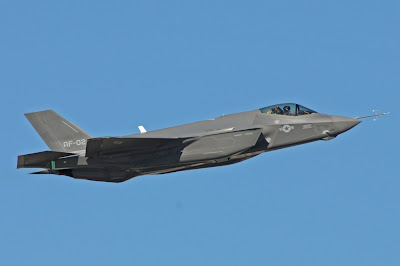
The T-38 has been the USAF's advanced pilot training aircraft since the late '50s. Generations of military pilots have trained in these aircraft. My father, who left the USAF in 1965, learned the figher pilot trade in and later instructed in the T-38.
Most of the 450 or so T-38s remaining in service have just gone through a major update/upgrade, and are now referred to as T-38C. T-38s were manufactured by Northrup from 1959 to 1970. The majority of those still flying were built in 1966, 67, and 68, making the average age of a front line T-38 about 45 years old.
 T-38A 68-8139, 7FS 49FW, based and photographed at Holloman AFB. These black jets were used for pilot proficiency and chase plane duties when the 49th was equipped with the F-117A Stealth Fighter.
T-38A 68-8139, 7FS 49FW, based and photographed at Holloman AFB. These black jets were used for pilot proficiency and chase plane duties when the 49th was equipped with the F-117A Stealth Fighter.The T-38C update will keep these aircraft in the air for another decade, if necessary.
The USAF has started the replacement process, finally. In a few months, a contest will be announced for designs and bids to produce the esimated 350 training aircraft deemed necessary to replace the T-38. The winning aircraft could garner as many as 1000 ordered, depending upon foreign customers and possible variations of the basic aircraft (such as a light strike platform).
The competitors appear to be:
Northrup - which is anticipated to offer a further upgrade/life extension program for the existing T-38 airframes.
Korean Air Industries/Lockheed-Martin - this partnership produced the Korean produced T-50 trainer, currently only in use by the South Korean Air Force.
Alenia Aermacchi - expected to offer a derivative of their M-346 trainer, currently in use by the Italian Air Force and others as both a trainer and light strike aircraft.
BAE Systems - which will offer a version of their Hawk training/light strike aircraft, used in the UK, US (Navy), and multiple Air Forces around the world.
Boeing - which is being very quiet about what it will offer, but is thought to be a new design purpose built for the application.
It is expected that some of these companies may team up to push an offering, with Alenia (Italy) and BAE (UK) seeking a US partner, either Northrup or Boeing. A cooperative effort would be stronger in many aspects.
Northrup has experience, in that they are the designers. makers, and maintainers of the current T-38 fleet. The last complete aircraft they produced, however, was the B-2 - very different technology and requirements, and production wrapped up over 15 years ago.
Alenia has worldwide experience with their MB platform, but very limited US experience - and that experience has been with the very limited use of the C-27 medium transport aircraft by the USAF. They would have to be considered an outsider.
BAE has a strong hand. The Hawk platform has dozens of customers worldwide, the most important of which (for this situation) the US Navy, which operates close to 300 of them. These aircraft, called T-45, were built in the US, and are highly modified examples of the main design. The mods were necessary to make the aircraft suitable for use on aircraft carriers. If BAE is chosen, the aircraft would likely be built through their partnership with Boeing, the same way the T-45 was produced.
Boeing, by itself, would have a hard time pushing a brand new aircraft to fill the need. With the spiralling costs and mismanagement seen in the F-22 and F-35 programs, Congress is not going to be in the mood to purchase billions of dollars worth of new, unproven designs when existing aircraft can be used with minimal program risk.
KAI/L-M's big advantage is that Lockheed is the manufacturer of the only two fighter aircraft that will be left in the inventory by the time the new trainer reaches operational capability - the F-22 and the F-35. L-M's familiarity with those aircraft would allow them to claim the knowledge necessary to build a trainer that would lead into the -22 and -35 seamlessly. There is a big drawback in that approach; since L-M has so much of the USAF's business, the Air Force and Congress may decide that the new contract needs to go to someone else.
No matter what design is chosen for the future requirement, it is certain that we will continue to see this sleek little jet flying around for many years to come.
 T-38A 70-1955, assigned to the 81FTW, based at Williams AFB. Seen landing at NAS Dallas in 1988. This was the second to last T-38 built.
T-38A 70-1955, assigned to the 81FTW, based at Williams AFB. Seen landing at NAS Dallas in 1988. This was the second to last T-38 built.
T-38C 64-13225 of the 25FTS, 71FTW, leads other T-38s from the 90FTS, 80FTW (EN) and 50FTS, 14FTW (CB) on the ramp during 2009.
All photos by your truly.


